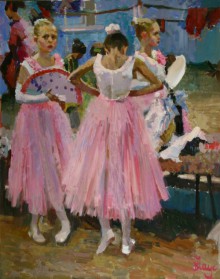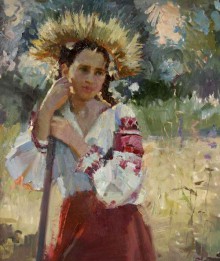The artist was born June 5, 1940 in the Yampil village of Donetsk oblast and gained his skills in the Crimean Art School. In 1966 he passed an exam to Kharkiv Industrial Art Institute, which has a strong “guild” tradition: talented innovators of the Ukrainian visual art were teaching there in 1920s-1930s, namely Anatolii Petrytsky and Fedir Krychevsky, and later – Mykola Samokysh, Mykhailo Derehus, and other masters who laid the foundation of Kharkiv painting school of the post-war period. Viktor Chaus studied there at the Faculty of monumental and decorative painting under the talented teachers: Serhii Solodovnyk, Yevhen Yehorov, Borys Kolisnyk, and Borys Kosariev. Having completed his graduation work in 1971 – an unrivaled painting of Hryhorii Skovoroda museum – he became a teacher-assistant the same year, and later – a senior lecturer of painting.
A glance on the master’s artwork makes apparent the fact that he considers all genres interesting and worthy of painting: he created a lot of portraits, still lifes, and landscapes. However, it seems that most distinctly his talent is revealed in the genre works, most of which are devoted to Ukrainian folk traditions. Today this idyllic world hardly exists, but his paintings bring our roots back to life with beautiful boys and girls clad in national dresses, engaged in a frantic dance. Turning to national subjects, it is difficult to resist its charm – so, the artist creates a certain archetype that follows some types of models known in the legacy of Abram Arkhipov (Dark Dance, 1912; Young Country Girl in Yellow Scarf, 1916), as well as characters from brilliant impressionistic masterpieces of Oleksandr Murashko, which had been created in Ukraine.
These parallels to recognized masters are no accident – Chaus is equally capable of “feeling” the color, of creating new exquisite palettes, and of delicately capturing that particular effect of sunlight that draws the viewers’ attention on the model and then dissolves in the air. The artist passionately and lusciously lays thick, barely diluted paint on the canvas, and creates an inspired mosaic of white, pink, yellow, and red colored spots, emphasizing the impression of life and movement around the main character.
The most striking and expressive examples of Viktor Chaus’s specific techniques is present in his genre paintings: Red Ruta, Holiday in The Countryside, The Fair. It is also worthy to recall the Red Necklace, where a beautiful young woman in bright festive national dress sits before a samovar – this work, by the way, like many others, combines complementary genres: portrait and still life. In Sewing we see a young woman in the garden, among the green wealth of magnificent giant trees and the dazzling rays of the summer sun. Sunbeams follows the same plot, but the model here is half-nude and depicted from the back, and the composition is based on a fairly complex mosaic of sunlight.
Incidentally, the theme of natural elements, to which the artist had a fondness since his student plain air paintings, is wonderfully reflected in a series of landscapes. Fortunately, the artist was able to travel around the world: he visited not only Ukrainian Crimea, but also Britain, and even the Arctic. In memory of these trips there are wonderful Broads Trail Streets, Landscape with Sails, The Boats, and The Yachts of the English Channel. The connoisseurs of Chaus’s artwork admire his wonderful still lifes: The Gladioli, The Flowers; and there is also the Self-Portrait in Red, which allows us to see the artist in a rather unusual, but essentially free and truly aesthetic perspective.
In addition to traditional domestic exhibitions, Viktor Chaus has been presenting his Impressionist artwork at international exhibitions, including the “Exhibition of Soviet painting” in Tokyo, Japan; in 1992 there were two large-scale displays in Chicago and Berlin. Since 1998 he has been serving as the President of the Painting Section of the Design and Fine Arts Academy, since 1999 he has been the Professor of painting at Kharkiv Art Institute. Many of his first-class artworks are kept in private collections across Japan, Israel, Germany, Poland, and the US.








